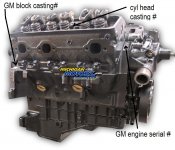timharper89
Petty Officer 1st Class
- Joined
- Jun 24, 2018
- Messages
- 277
Long story short, my 1987 Four Winns Sundowner 195 developed a knock/rattle this summer when it ran low on oil (for more on that, see my other thread). My wife and I are contemplating cutting our losses as we were considering buying something a bit newer and more in the 23 foot range (really like the layout of the rinker captiva 232 cc or regal 6.8 ventura around the year 2000), but our budget is a little limited, and we may end up a season without a boat while waiting for the right deal to come along. The hull seems to be sound (floors feel solid, no flex in the transom and the stringers feel solid), so I was considering attempting to rebuild the engine myself. I tried looking around without much luck of finding how much rebuilding the engine myself would cost vs buying a long block. My wife is concerned about taking such a risk (I mess it up somehow, and now we're out $XXX instead of just cutting our losses and selling the boat as is, but I'm thinking rebuilding could be a low cost option to get us by for a few more years and allow us to casually look for the right boat instead of just wanting to be on the water again and making compromises for short term happiness.
The boat has been sluggish since we bought it 4 years ago and fully loaded with 6 adults and 2 kids (only that full once or twice a year) can take VERY long to plane out....like a full minute or more (propped correctly with 4 blade alum prop for 4400rpm @ WOT), and topped out at 33mph gps with 3 adults on board. It has had one cylinder with blowby since we bought it. Would rebuilding give the motor more oomph? Would it be likely to feel a significant increase in performance, namely hole shot?
TLDR: What is a ball park figure for rebuilding my own engine? (Parts and machining, etc.) and how much would I save vs buying a rebuilt long block for just under $2k shipped?
Will I see decent power increase from previously running with one cylinder with low (100psi<other cylinders) compression?
I have the engine shop manual. What other resources and tools beyond standard tools would be required for this job?
A boat this old, should I just cut my losses and look for something new or is it worth hanging onto for a few more years while we casually look for the right boat within our relatively low budget? Thanks for any info.
The boat has been sluggish since we bought it 4 years ago and fully loaded with 6 adults and 2 kids (only that full once or twice a year) can take VERY long to plane out....like a full minute or more (propped correctly with 4 blade alum prop for 4400rpm @ WOT), and topped out at 33mph gps with 3 adults on board. It has had one cylinder with blowby since we bought it. Would rebuilding give the motor more oomph? Would it be likely to feel a significant increase in performance, namely hole shot?
TLDR: What is a ball park figure for rebuilding my own engine? (Parts and machining, etc.) and how much would I save vs buying a rebuilt long block for just under $2k shipped?
Will I see decent power increase from previously running with one cylinder with low (100psi<other cylinders) compression?
I have the engine shop manual. What other resources and tools beyond standard tools would be required for this job?
A boat this old, should I just cut my losses and look for something new or is it worth hanging onto for a few more years while we casually look for the right boat within our relatively low budget? Thanks for any info.






















